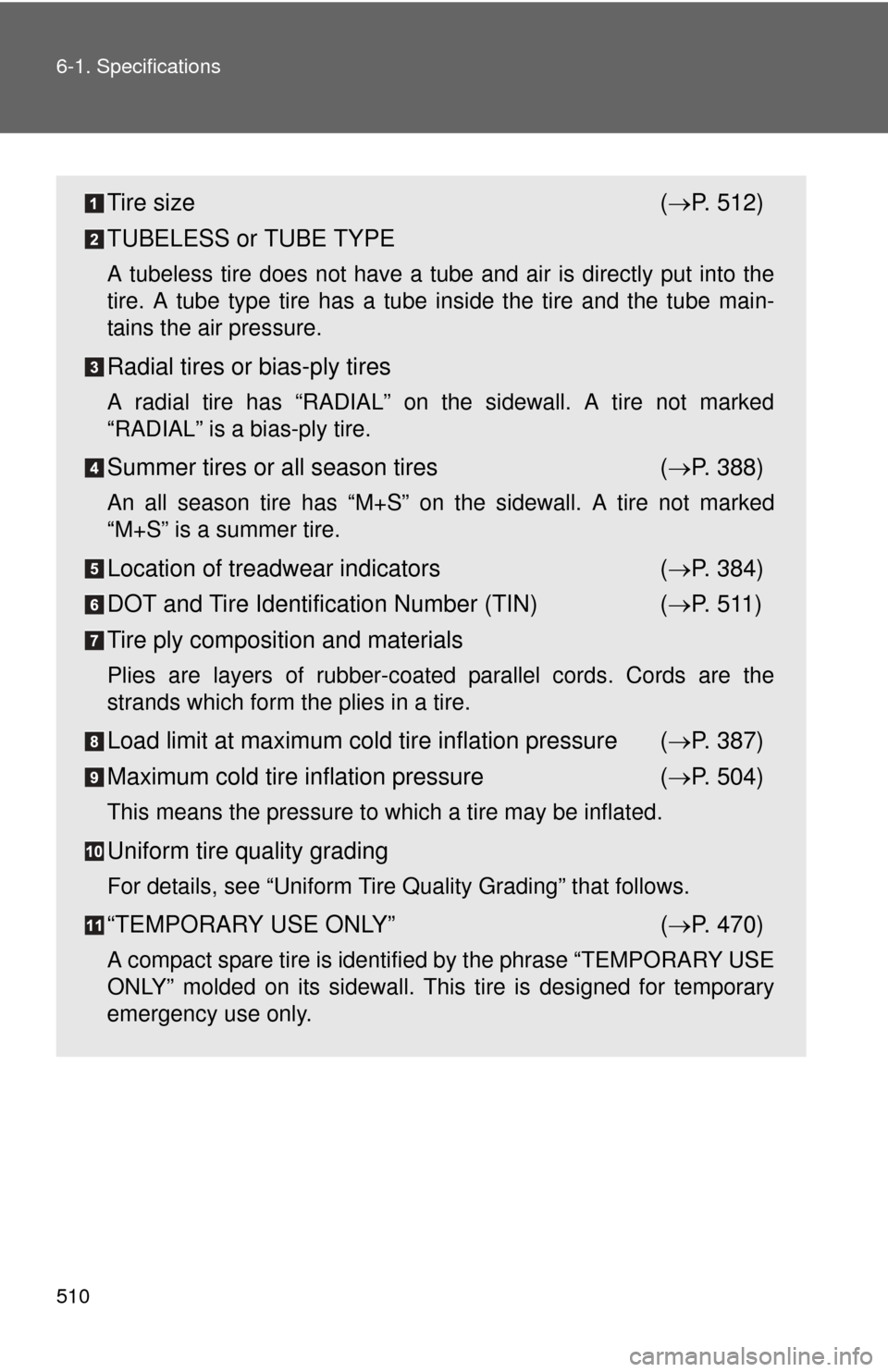Page 495 of 563

492
5-2. Steps to take in an emergency
If the vehicle becomes stuck
CAUTION
■When attempting to free a stuck vehicle
If you choose to push the vehicle back and forth to free it, make sure the sur-
rounding area is clear to avoid striking other vehicles, objects or people. The
vehicle may also lunge forward or lunge back suddenly as it becomes free.
Use extreme caution.
■ When shifting the shift lever
Be careful not to shift the shift lever with the accelerator pedal depressed.
This may lead to unexpected rapid acceleration of the vehicle that may
cause an accident resulting in death or serious injury.
NOTICE
■To avoid damage to the transmission and other components
●Avoid spinning the wheels and depressing the accelerator pedal more
than necessary.
● If the vehicle remains stuck even after these procedures are performed,
the vehicle may require towing to be freed.
Carry out the following procedures if the tires spin or the vehicle
becomes stuck in mud, dirt or snow:
Shift the shift lever to P and set the parking brake. Stop the
hybrid system.
Remove the mud, snow or sand from around the stuck tire.
Place wood, stones or some other material under the tires
to help provide traction.
Restart the hybrid system.
Shift the shift lever to the D or R position and carefully apply
the accelerator to free the vehicle.STEP1
STEP2
STEP3
STEP4
STEP5
Page 499 of 563
496
6-1. Specifications
Maintenance data (fuel, oil level, etc.)
Dimensions and weights
*1: Unladen vehicles
*2: P175/65R15 tires
*3: P195/50R16 tires
Overall length157.3 in. (3995 mm)
Overall width66.7 in. (1695 mm)
Overall height*1
Without moon roof
56.9 in. (1445 mm)
With moon roof 57.7 in. (1465 mm)
Wheelbase 100.4 in. (2550 mm)
Tread
Front58.3 in. (1480 mm)*2
57.5 in. (1460 mm)*3
Rear58.1 in. (1475 mm)*2
57.1 in. (1450 mm)*3
Vehicle capacity weight
(Occupants + luggage) 845 lb. (380 kg)
Page 507 of 563
504 6-1. Specifications
Tires and wheels
15-inch tires
16-inch tires
Tire size P175/65R15 84H, T125/70D16 96M
(spare)
Tire inflation pressure
(recommended cold
tire inflation pressure)Front:
35 psi (240 kPa, 2.4 kgf/cm
2 or bar)
Rear:
33 psi (230 kPa, 2.3 kgf/cm
2 or bar)
Spare:
60 psi (420 kPa, 4.2 kgf/cm
2 or bar)
Never exceed the maximum cold tire infla-
tion pressure indicated on the tire sidewall.
Wheel size 15 5J, 16 4T (spare)
Wheel nut torque 76 ft•lbf (103 N•m, 10.5 kgf•m)
Tire size P195/50R16 83V, T125/70D16 96M
(spare)
Front and rear tire inflation
pressure
(recommended cold tire
inflation pressure)Front:
32 psi (220 kPa, 2.2 kgf/cm
2 or bar)
Rear:
29 psi (200 kPa, 2.0 kgf/cm
2 or bar)
Spare:
60 psi (420 kPa, 4.2 kgf/cm
2 or bar)
Never exceed the maximum cold tire infla-
tion pressure indicated on the tire sidewall.
Wheel size 16 6J, 16 4T (spare)
Wheel nut torque 76 ft•lbf (103 N•m, 10.5 kgf•m)
Page 513 of 563

510 6-1. Specifications
Tire size( P. 512)
TUBELESS or TUBE TYPE
A tubeless tire does not have a tube and air is directly put into the
tire. A tube type tire has a tube inside the tire and the tube main-
tains the air pressure.
Radial tires or bias-ply tires
A radial tire has “RADIAL” on the sidewall. A tire not marked
“RADIAL” is a bias-ply tire.
Summer tires or all season tires ( P. 388)
An all season tire has “M+S” on the sidewall. A tire not marked
“M+S” is a summer tire.
Location of treadwear indicators ( P. 384)
DOT and Tire Identification Number (TIN) ( P. 511)
Tire ply composition and materials
Plies are layers of rubber-coated parallel cords. Cords are the
strands which form the plies in a tire.
Load limit at maximum cold tire inflation pressure ( P. 387)
Maximum cold tire in flation pressure ( P. 504)
This means the pressure to which a tire may be inflated.
Uniform tire quality grading
For details, see “Uniform Tire Quality Grading” that follows.
“TEMPORARY USE ONLY” ( P. 470)
A compact spare tire is identified by the phrase “TEMPORARY USE
ONLY” molded on its sidewall. This tire is designed for temporary
emergency use only.
Page 516 of 563
513
6-1. Specifications
6
Vehicle specifications
Tire section names
Bead
Sidewall
Shoulder
Tread
Belt
Inner liner
Reinforcing rubber
Carcass
Rim lines
Bead wires
Chafer
Uniform Tire Quality GradingThis information has been prepared in accordance with regulations
issued by the National Highway Tr affic Safety Administration of the
U.S. Department of Transportation.
It provides the purchasers and/or prospective purchasers of Toyota
vehicles with information on uniform tire quality grading.
Your Toyota dealer will help answ er any questions you may have as
you read this information.
■ DOT quality grades
All passenger vehicle tires mu st conform to Federal Safety
Requirements in addition to these grades. Quality grades can be
found where applicable on the tire sidewall between tread shoulder
and maximum section width.
For example: Treadwear 200 Traction AA Temperature A
Page 517 of 563

514 6-1. Specifications
■Treadwear
The treadwear grade is a comparative rating based on the wear
rate of the tire when tested under controlled conditions on a speci-
fied government test course.
For example, a tire graded 150 would wear one and a half (1 - 1/2)
times as well on the government course as a tire graded 100.
The relative performance of tires depends upon the actual conditions
of their use. Performance may diff er significantly from the norm due
to variations in driving habits, service practices and differences in
road characteristics and climate.
■ Traction AA, A, B, C
The traction grades, from highest to lowest, are AA, A, B and C,
and they represen t the tire's ability to stop on wet pavement as
measured under controlled cond itions on specified government
test surfaces of asphalt and concrete.
A tire marked C may have poor traction performance.
Warning: The traction grade assigned to this tire is based on braking
(straight ahead) traction tests and does not include cornering (turn-
ing) traction.
Page 518 of 563
515
6-1. Specifications
6
Vehicle specifications
■
Temperature A, B, C
The temperature grades are A (the highest), B, and C, represent-
ing the tire's resistance to the generation of heat and its ability to
dissipate heat when tested under controlled conditions on a speci-
fied indoor laboratory test wheel.
Sustained high temperature can cause the material of the tire to
degenerate and reduce tire life, and excessive temperature can lead
to sudden tire failure.
Grade C corresponds to a level of performance which all passenger
car tires must meet under the Federal Motor Vehicle Safety Standard
No. 109.
Grades B and A represent higher levels of performance on the labo-
ratory test wheel than the minimum required by law.
Warning: The temperature grades of a tire assume that it is properly
inflated and not overloaded.
Excessive speed, underinflation, or excessive loading, either sepa-
rately or in combination, can caus e heat buildup and possible tire fail-
ure.
Page 531 of 563
528
6-2. Customization
Items to initialize
ItemWhen to initializeReference
Maintenance data
(except Canada)After the maintenance is performedP. 353
Tire pressure warning
system
• When rotating the tires on vehicles with differing front and rear tire
inflation pressures
• When changing tire pressure (such as when changing traveling speed,
load weight, etc.)
• When changing the tire size
P. 3 8 5
The following items must be initia lized for normal system operation
after such cases as the 12-volt batt ery being reconnected, or mainte-
nance being performed on the vehicle: